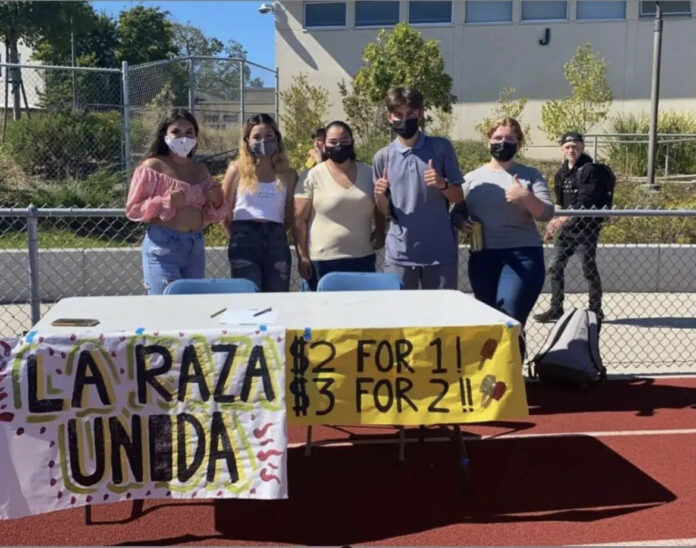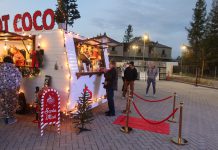The name of La Raza Unida Club at West County High School (WCHS) has a deeper meaning when the backstory behind it is learned. Following the consolidation of El Molino and Analy high schools, El Molino’s La Raza Club and Analy’s MECHA joined forces and became united — which is what ‘unida’ translates to from Spanish.
In August, students from El Molino and Analy High School began attending school together.
“That’s when Wendy (Angeles) reached out to La Raza last year. She brought up the idea to merge both clubs. So we did in order to unify the student body, because that’s both of our goals,” said WCHS student and club member Dylan Peña Pérez.
MECHA, short for Movimiento Estudiantil Chicano de Aztlán, is a student organization started with the Chicano movement and was first established in Santa Barbara in 1969. While it used to be a club for universities, the club now has presence in high schools and middle schools all over the United States.
Angeles, who was an Analy student, began attending MECHA her freshman year.
“We did see a huge decrease (in attendance), probably sophomore year, just because everything was being transitioned online,” Angeles said, noting that engagement has picked up for the new La Raza Unida Club. Currently the club has a little over 40 members.
For her and several of MECHA club members, being a part of the club gave them a sense of community and a safe space where they felt they belonged.
“The culture at Analy — I don’t know how to put it lightly — but it was very much dominated by the white population of students. It’s really hard to get engaged,” she said.
Peña Pérez and Axiri Sanchez were both part of La Raza Club while attending El Molino.
La Raza Club focused on fundraising efforts, while MECHA focused on promoting Latinx higher education.
“Because as we know, lots of fields in STEM are white-dominated, especially by white men. We wanted to definitely show the students, because a lot of them are very discouraged — like people that are ESL (English as a second language), people who have different backgrounds — they don’t have all these resources to push themselves forward,” Angeles said.
“We wanted to present them with all these careers and we really stepped into having people come in that are from the Latinx culture and sort of layout and pitch their careers,” she said.
The club had people of different careers in STEM attend meetings and talk about what it was like to get to their position.
“I think that really helped people to come in because they’re like, ‘Oh, that’s interesting’,” Melani Lozano, who was a member of MECHA said.
The transition from two clubs to one has not been difficult. Peña Pérez and Lozano both said it has been a nice experience to work together as a team. Before they attended school in person the club met over Zoom meetings which developed into the creation of La Raza Unida.
“I feel like it was a great idea to merge both clubs. Because if we didn’t, we’d have two separate clubs competing against each other — both clubs are looking to do the same thing in the school, which is to elevate the Latinx students — we’re definitely more powerful together,” Pena said.
The club currently sells masks as a fundraiser, it has sold paletas, or popsicles, and did murals as well as an ofrenda in Santa Rosa for Día de los Muertos. La Raza Unida currently has around $2,100 in savings which is undecidedly planned to be used for graduation sashes, scholarships and an end of the year trip for members to Six Flags.
For many of the members, a relative or someone older in their inner circle was the first introduction to their initial club. This is why they decided to join and were interested to begin with.
“For me, my madrina (godmother) had been part of it when she was in high school. And growing up, she would always tell me about it. She would take me to some events,” Angeles said.
“Being a part of something that you like, you relate to so much, and finding these people that are passionate about the same things, and think the same way as you and can relate to you on so many levels that many other students at this school couldn’t. That really helped and just like the friendships I made in that club, made me stay,” she said.
For Lozano, her sister was who introduced her to MECHA.
“She would always talk about how there’d be so many meetings and when people would just have fun and be unida,” Lozano said.
“And that just made me realize, there’s other people like me and I want to be in that community, where we feel safe, where we speak Spanish, or we express our cultures, it just feels like a safe environment,” she said.
In Sanchez’s case, her sisters were who encouraged her to join La Raza. She said she liked how the club gave back to the community in a fun way.
“A club that I could relate to more than, you know, any other students at the school, was pretty comforting. So that’s why I joined,” Sanchez said.
For Peña Pérez, a friend of his introduced him and he has been enjoying it since then.
“I felt welcomed. It was nice to be surrounded by people who talk like me and share the same culture as me. It was like a family,” he said.
Angeles explained growing up she struggled to find herself represented in her school setting.
“Sebastopol is very much like, there’s no people of color basically. It’s just very difficult to navigate that because, when I was growing up, I spoke Spanish as my first language and no one really understood me,” Angeles said.
“Coming here I definitely experienced culture shock. But just being a part of that definitely eased the transition to a bigger population of students that didn’t look like me,” she said.
At the same time, Angeles added she has witnessed racist remarks around the school campus which have encouraged her to highlight Latinx culture.
“There’s some people that are just very rude, they just don’t think. Especially with the past election, that definitely increased the political tension that definitely did lead to some very rude racist things and just actions and they were never really held accountable, which just sucks,” Angeles said.
The club’s ultimate goal is to have a presence and to leave a legacy.
“I hope that more people get involved and it holds its power that it has now,” Sanchez said.
“My main goal is to keep the club going even after we all graduate for the years that come because it’s necessary for that experience to have a community where they can feel comfortable in order to succeed, both academically and in real life,” Peña Pérez said.









The original Raza Unida club started at Analy HS in 1994. It was started theough blood, sweat, and tears of the Raza back then when prop 187 was on the ballot. We didn’t have no latin x or fear of telling it like it was. We also included people of all backgrounds. “No sabo” kids were not pushed away. They were accepted with open arms because the real struggle was against the racists back then and not our own indigenous roots. One love and learn your history young kids.